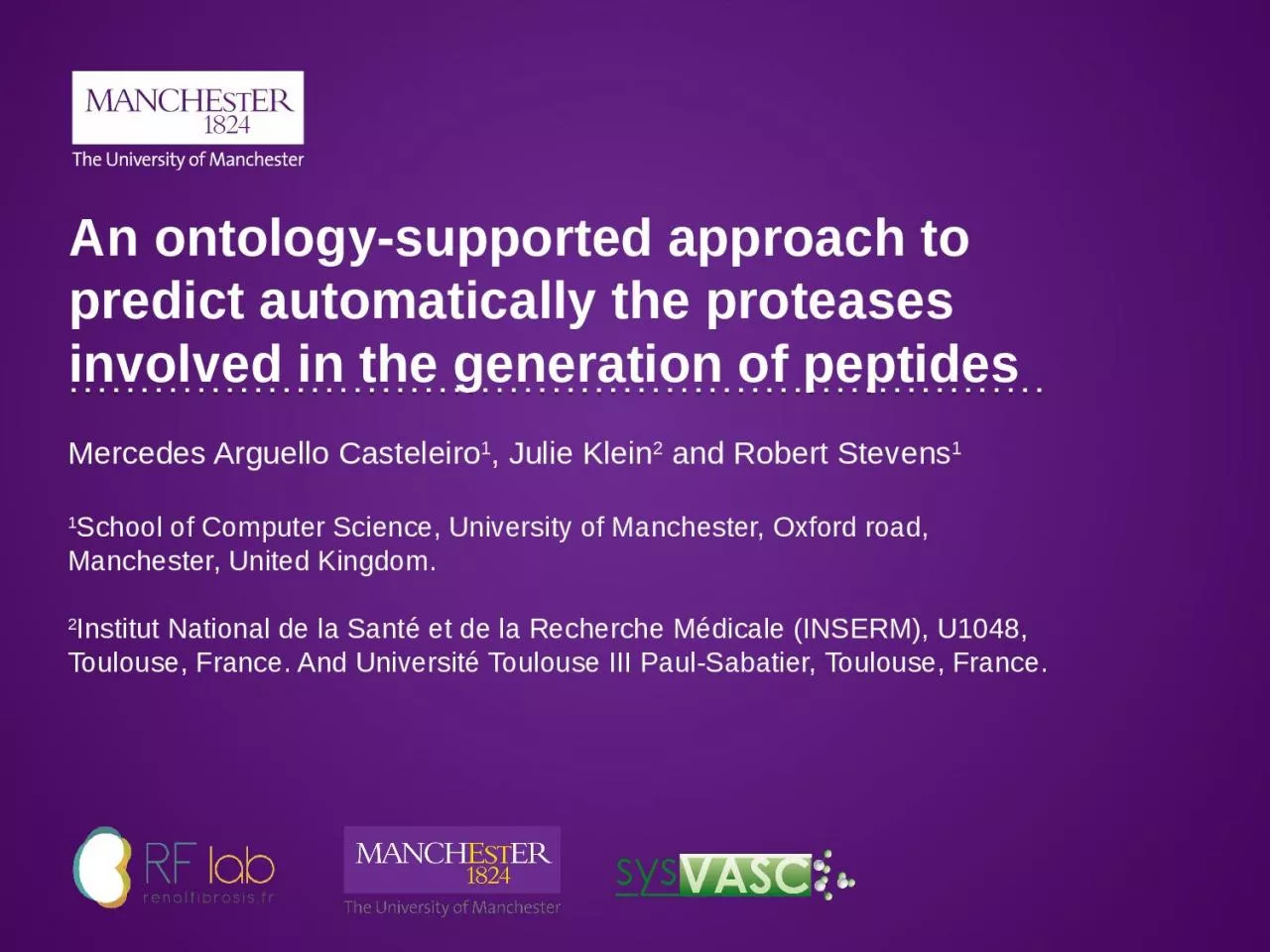

Mercedes Arguello Casteleiro 1 Julie Klein 2 and Robert Stevens 1 1 School of Computer Science University of Manchester Oxford road Manchester United Kingdom 2 Institut National de la ID: 917166
Download Presentation The PPT/PDF document "An ontology-supported approach to predic..." is the property of its rightful owner. Permission is granted to download and print the materials on this web site for personal, non-commercial use only, and to display it on your personal computer provided you do not modify the materials and that you retain all copyright notices contained in the materials. By downloading content from our website, you accept the terms of this agreement.
Slide1
An ontology-supported approach to predict automatically the proteases involved in the generation of peptides
Mercedes
Arguello Casteleiro1, Julie Klein2 and Robert Stevens11School of Computer Science, University of Manchester, Oxford road, Manchester, United Kingdom. 2Institut National de la Santé et de la Recherche Médicale (INSERM), U1048, Toulouse, France. And Université Toulouse III Paul-Sabatier, Toulouse, France.
Slide2Biomedical Background
Complex diseases cannot be adequately described by
single features:Interindividual differencesMechanism multiplicitywhy omics? Omics: studying “all” molecules collectively
Slide3Tools & Applications
Peptides represent a new source of very useful biomarkers in kidney and other disease.Peptides can help better understanding the pathophysiological mechanisms:Parental proteins
Proteases
ProteaseParent
protein
Peptide
Slide4Tools & Applications
Initially:
Very tedious work!
HELP ?
Peptides represent a new source of very useful biomarkers in kidney and other disease.Peptides can help better understanding the pathophysiological mechanisms
:Parental proteinsProteases
Slide5Proteasix
Ontology (
PxO) reuse ontologies
Slide6Proteasix
Ontology (
PxO) reuse ontologieschemical entitymolecular entityAlanine
Slide7Proteasix
Ontology (
PxO) reuse ontologiesHumanRatMouse
Slide8Proteasix
Ontology (
PxO) reuse ontologiesmolecular_functioncellular_componentbiological_process
Slide9Proteasix
Ontology (
PxO) reuse ontologiesProteinamino acid chainproteolytic cleavage product
Slide10Current Work: Proteasix Ontology (PxO
)UniProt KB proteins (Swiss-prot and TrEMBL
)Organised by Taxons following PRO ontologyAnnotated with GO biological_process; GO cellular_component; and GO molecular_functionModel cleavage sites patterns forExopeptidase activityEndopeptidase activity
Slide11For using Peptides as Biomarkers, we needmore data.. and data linkage..
Class:
polypeptide_region SubClassOf: biological_region part_of
some protein, associated_with some 'proteolytic
cleavage product', only_in_taxon some organism
OWL
(
ontologies
)
Let’s glue the relevant knowledge together
Slide12In Swiss-
Prot
there are proteins annotated with GO:0004252, which is serine-type endopeptidase activitySELECT ?x FROM <file:./ontofiles/Swiss-Prot.owl> { ?x rdf:type owl:Class;
rdfs:subClassOf [ a owl:Restriction ;
owl:onProperty pr:has_function ; owl:someValuesFrom
obo:GO_0004252 ] .
}
SPARQL
(
queries
)
Let’s get them!
For using Peptides
as
Biomarkers,
w
e need
more data.. and data linkage..
Slide13Can we retrieve from Swiss-
Prot
ALL the proteins annotated with any DESCENDANT of Peptidase activity GO_0008233 ?SPARQL(queries)
Let’s get
Pepetidase
Activities from GO, e.g. serine-type
endopeptidase activity GO:0004252
GRAPH <file:./
ontofiles
/
GO_TAXONOMY_molecular_function.owl
> {?C
rdfs:subClassOf
+ obo:GO_0008233 . } .
For using Peptides
as
Biomarkers,
w
e need
more data.. and data linkage..
Slide14Can we retrieve from Swiss-
Prot
ALL the proteins annotated with any DESCENDANT of Peptidase activity GO_0008233 ?SPARQL(queries)
For using Peptides as Biomarkers,
w
e need
more data.. and data linkage..
SELECT ?x FROM <file:./
ontofiles
/Swiss-
Prot.owl
)>
FROM NAMED <file:./
ontofiles
/
GO_TAXONOMY_molecular_function.owl
>
{
GRAPH
<file:./
ontofiles
/
GO_TAXONOMY_molecular_function.owl
>
{?C rdfs:subClassOf+ obo:GO_0008233 . } .
{ ?x rdf:type owl:Class;
rdfs:subClassOf
[ a
owl:Restriction
;
owl:onProperty
pr:has_function
;
owl:someValuesFrom
?C
]
.
}
}
YES!
l
et’s
get
proteins annotated with
Pepetidase
Activities from GO
Slide15Concluding remarks
TopFIND2 and
Proteasix can help to automatically predict modification of protease activityCurrent work: exploring the benefits of using Proteasix ontology (PxO) in the Semantic-Web version of Proteasix Hard Limits:Prediction always need validation
Data available (over-representation of some proteases, other are missing)
Slide16Biomedical
background
Comparison of Current Tools & ApplicationsACKNOWLEDGMENT: to Julie Klein for providing